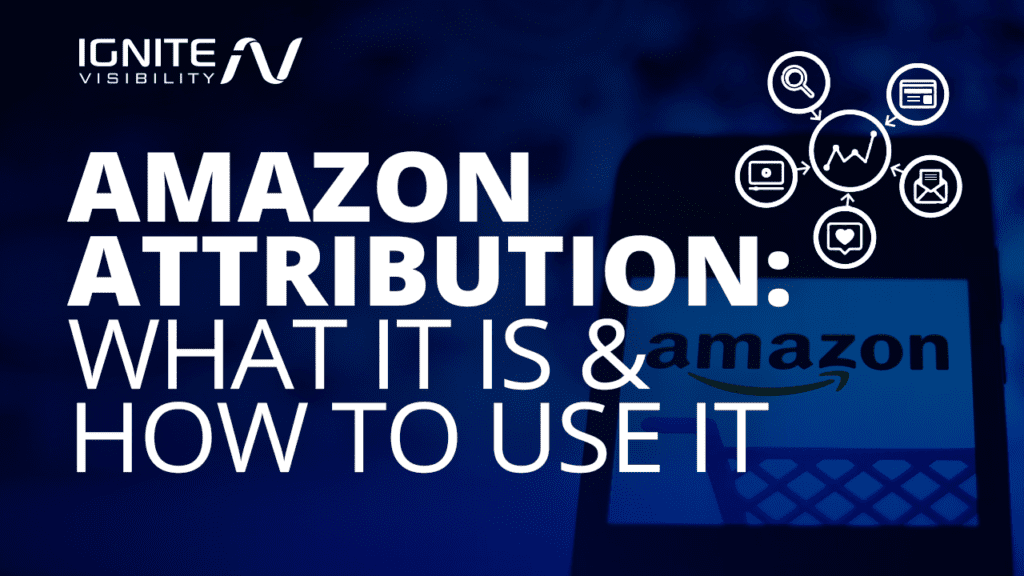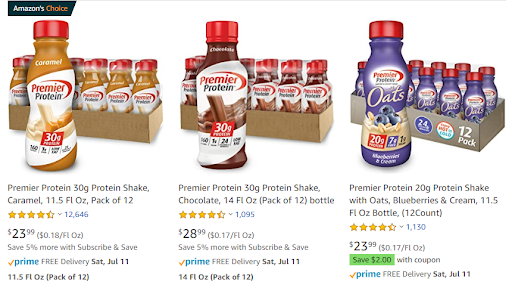In short, Amazon Attribution is a form of Amazon Advertising that functions as a measurement and analytics console.
The platform is currently free and helps users trail the performance of their media and advertising efforts on and off Amazon.
Not enough of an explanation? Don’t worry. We’ve got the long story, too — and a guide on how to use it.
What We’ll Cover:
- What is Amazon attribution and what are its benefits?
- How Amazon is using attribution tags to track customer behavior
- What was Amazon doing before to measure buyer metrics?
- How can you tell if you’re eligible for the beta?
- How to set up and use Amazon attribution
- Amazon attribution console features you should know
- Case studies
Amazon Attribution Is Still In Beta Mode, But It Has Benefits
Amazon has a stronghold on American online shopping. In fact, the company has a 49% share of America’s Ecommerce market, or a 5% share of all retail activity in the nation.
For anyone with Ecommerce listings of any kind on the website, there’s no denying that Amazon Advertising is a lucrative route.
The Amazon Attribution console is still in beta-testing mode (and has been since 2017, when a select few were able to try it out for themselves), but the product as a whole looks promising.
Not only can you view post-campaign reporting, but you can also request on-demand reports that help you optimize a campaign while it’s still going on.
By gleaning useful metrics, you can build a targeted marketing strategy that drives conversions for your Ecommerce listings.
For Amazon Attribution, it’s all in the name. According to Marketing Evolution, marketing attribution is the “analytical science of determining which marketing tactics are contributing to sales or conversions.”
When you think about it, it makes total sense that this console helps Ecommerce folks determine the sources of their marketing success in precise terms.
There are some additional benefits that come with utilizing Amazon Attribution for your Ecommerce listings:
- Gather data on your media investments and the effectiveness of each channel.
- Maximize your ROI by analyzing the sources of your sales and conversions.
- Collect valuable insights from each stage of the buyer’s journey (awareness, consideration and purchase), which can help strengthen your marketing efforts moving forward.
- Determine the effectiveness of off-platform digital marketing campaigns leading toward your Ecommerce listings.
- Ultimately, send ad traffic directly to your Ecommerce listings on Amazon. This increases your product ranking, customer purchases and chance of sales.
- Marketers report using at least six tools to measure their marketing performance. For people with Ecommerce listings on Amazon, this consolidates platforms, boosts efficiency and minimizes any marketing fatigue your team may be experiencing.
- It’s also currently free, so there’s that.
How Does It Work?
Look to places like Facebook and Google Shopping for attribution marketing and you’ll use a “pixel” to track customer behavior.
In this case, a tracking pixel is a small chunk of code that allows you to collect data on consumer behavior and flow (think how and where they browse, and what ads they click on).
The thing with pixels is they only work if a company owns the website. Amazon blocks tracking pixels from Facebook, Google Shopping and elsewhere because they don’t want these sites to know the nitty-gritty about Amazon customer behavior.
So instead of pixels, Amazon Attribution uses something called Attribution Tags to track customer behavior.
According to Amazon, Attribution Tags are “parameterized URLs that measure click-throughs and attribute conversions and sales of their products on Amazon.”
No need for a dictionary here. Let’s break that down:
- Attribution Tags are URLs (tags) to your Amazon Ecommerce listings that are trackable by Amazon.
- You can generate these tags on your Amazon Attribution
- Place the URL on external media like ads, blog posts, email campaigns and more.
- When someone clicks that link, you’ll have access to analytics about their traffic, actions and buying journey.
Check out this brief video from Amazon Advertising themselves, where they skim the surface on their beta-mode Amazon Attribution console.
The Backstory: Campaign Analysis Before Amazon Attribution
Before Amazon Attribution, analyzing buyer metrics for your Ecommerce listings on the site was a shot in the dark.
They marked anyone who stumbled on your listing via an Amazon PPC link as a single source.
Everyone else was shoved into the same category, so you couldn’t really get a nuanced picture of the effectiveness of your campaigns.
The non-Amazon PPC buyers could have been from anywhere, including organic traffic, paid ads and a slew of other sources.
As you can imagine, this practice made it difficult for people to break apart their marketing efforts to see precisely what was — and wasn’t — working.
Amazon Attribution came along and changed the company’s own status quo. For those who are eligible, it’s made all the difference in campaign effectiveness and efficiency.
How To Know If You’re Eligible
Currently, the beta version is available in only two countries: the United States and United Kingdom. But there aren’t many loopholes to getting a spot on the Amazon Attribution console, unlike Google’s fact check .
If you’re in the US or UK, you must be a:
- Professional seller who is enrolled in Amazon Brand Registry
- Vendor
- Agency with clients who sell products on Amazon
Basically, you just need to be a first-party or third-party seller on Amazon who is brand registered in order to access the Amazon Attribution console. It’s as easy as that.
Getting Started: How To Use Amazon Attribution To Boost Your Ecommerce Listings
You’re eligible and want to know how to hop on the attribution bandwagon? We’ve got you covered.
1. Join Amazon Attribution
First thing’s first. It’s time to join Amazon Attribution.
Vendors/Agencies: Fill out the webform here.
Sellers: Sign in to Seller Central and register for the program here.
2. Sign in to your account
Now that you have an account, you can sign in and add each product you want data on.
3. Create Attribution Tags
Creating an Attribution Tag within the console involves a few simple steps.
First, identify the advertiser who you want to create the tag for. Click on their name and then click the “New Order” button.
Tags for Google Ads: Click “Upload a file (Google Ads only)”
Tags for other campaigns: Click “Set up an order”
Now, when you scroll down, you’ll find a place to enter the order settings. This is where you give your Attribution Tag a name and external ID (the external ID is optional, but helpful if you have numerous tags). Once you finish this step, click the “Continue to line items” button.
In the new line item web form, click the drop-down menu to select a publisher. The publisher is the site where you’ll place the URL externally.
Amazon gives you hundreds of options to choose from, including Facebook, Gannett news sites, eBay and so much more.
Once you choose the publisher, implement the click-through URL, otherwise known as the URL of the product you’re trying to sell. This link should be quite long.
Once you’ve completed all of these steps, you’ve successfully created an Attribution Tag for one of your Amazon Ecommerce listings.
4. Implement your tags
Now that you have your Attribution Tags, it’s time to put them to work. Add them to your external marketing campaigns and start tracking customer behavior like you were born to do it.
Know the Features
Once you’re in, you’ll need to know your way around the Amazon Attribution console. Here are some primary features you can expect to help boost your Ecommerce listings:
Metrics: Amazon Attribution lets you measure off-Amazon Advertising via Attribution tags. This means you can analyze media such as search ads, social ads, display ads, video ads and email marketing. The reports on your console contain standard Amazon traffic data like impressions, clicks, conversion metrics, Add to Carts and purchases. Transactional metrics tell you the number of purchases, purchase rate and total sales. You can download these reports right from your Amazon Attribution console, either on-demand or by scheduling a report.
Collaboration: You can even invite additional users to hop in on your Amazon Attribution console. This could mean adding agency partners or colleagues of any kind. To grant permission for other users, go to your top navigation, click “Manage” and choose “User management”.
Can We Expect a Full Pilot?
Amazon Attribution just became available for UK vendors in early 2019, tacking onto the already eligible US vendors. That same year, US sellers were granted the opportunity to hop on the bandwagon.
Needless to say, this beta platform is still fairly new.
A full pilot is definitely en route. We’re not sure how long this beta test will go on for, but it’s already providing valuable insights for US and UK businesses.
If you fall under that category, there’s no better time than the present to do some attribution digging.
While Amazon Attribution is currently free, their website uses the terminology “at this moment, there is no cost associated with participating” to describe their platform.
This leaves the future possibility of a fee open should the platform move out of beta stage, though nothing is set in stone.
Examples of Amazon Attribution At Work
Amazon Advertising provides a number of case studies regarding their beta console. Here are a couple of our favorites, including :
Midwest Homes for Pets
Midwest Homes for Pets Amazon Attribution Case Study
Midwest Homes for Pets used Amazon Attribution insights to optimize marketing for their Ecommerce listings.
The brand relished in a 32% increase in their return on advertising spend (ROAS).
They utilized on-Amazon metrics like product detail page views and Add to Carts, as well as off-Amazon metrics like clicks, ad spend and cost per click.
Ultimately, Midwest Homes for Pets gained a clear vision on how their marketing investments impacted their Amazon sales.
Premier Nutrition
Premier Protein Amazon Attribution Case Study
Premier Nutrition has a host of Premier Protein products listed on Amazon. The company was one of the first to try Amazon Attribution, way back in 2017.
The results were massive. A 96% quarter-over-quarter growth in sales. A 322% year-over-year growth in sales.
All from a detailed analysis of cross-channel media activity and subsequent campaign reassessment.
Their newly quantifiable media investments ignored the boundaries of digital channels, and they did it all under one umbrella.
This Isn’t Your Only Option for Amazon Advertising
The Midwest Homes for Pets and Premier Nutrition case studies are impressive, but you don’t have to be so easily swayed.
If you’re not ready to join Amazon Attribution — or if you’re still ineligible — there are other options to track marketing efforts for your Amazon Ecommerce listings.
Amazon Associates Tracking Links: Amazon Associates is the company’s affiliate program. By signing up for an Amazon Associates Account, you can collect affiliate links to place externally. You’ll earn revenue anytime someone clicks the links and subsequently purchases the product. Why’s the revenue relevant? It represents all sales you received via your affiliate link, which provides you with data on customer behavior. You can also collect multiple Tracking IDs.
Pixelfy.me Links: Pixelfy.me is a beneficial tool if you want to track clicks. It’s important to note that it doesn’t track sales unless you use an Amazon Associates affiliate code. It works by using something called “Super URLs” or URLs that manipulate the Amazon algorithm.
In a Nutshell: Attributing Successes (and Failures) for Ecommerce Listings
Not every one of your Ecommerce listings will be a winner, but there are ways to optimize your chances for success.
Analyzing your metrics can help you figure out where exactly your traffic comes from on successful listings.
At the same time, you can pick apart the flops to see what you did wrong, and vow to change your tactics moving forth.
Basically, the Amazon Attribution console provides you with a way to track your digital marketing off Amazon to Amazon, as well as see what’s going on within the Ecommerce platform itself.
To try it for yourself, simply follow the steps listed above and give it a whirl. You just might be amazed at what you uncover.



